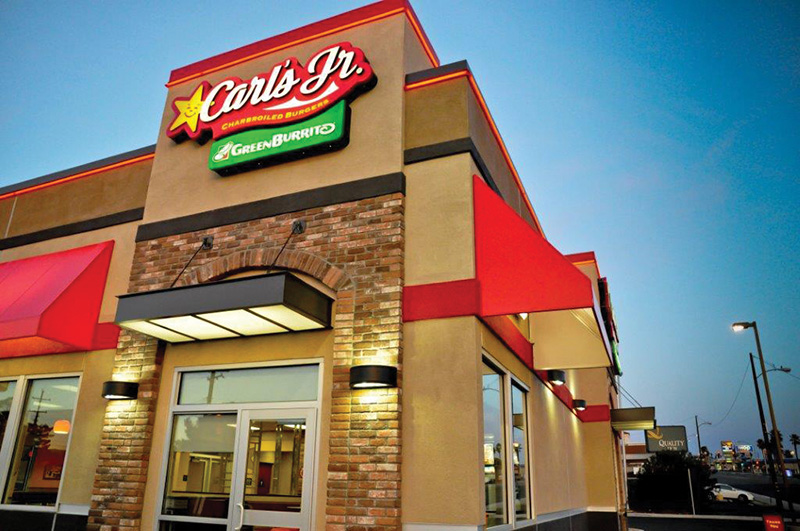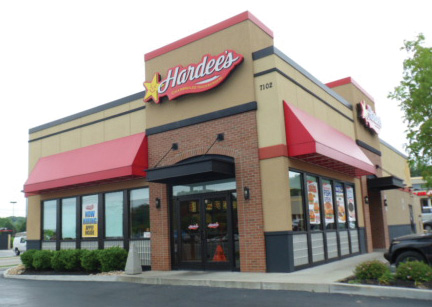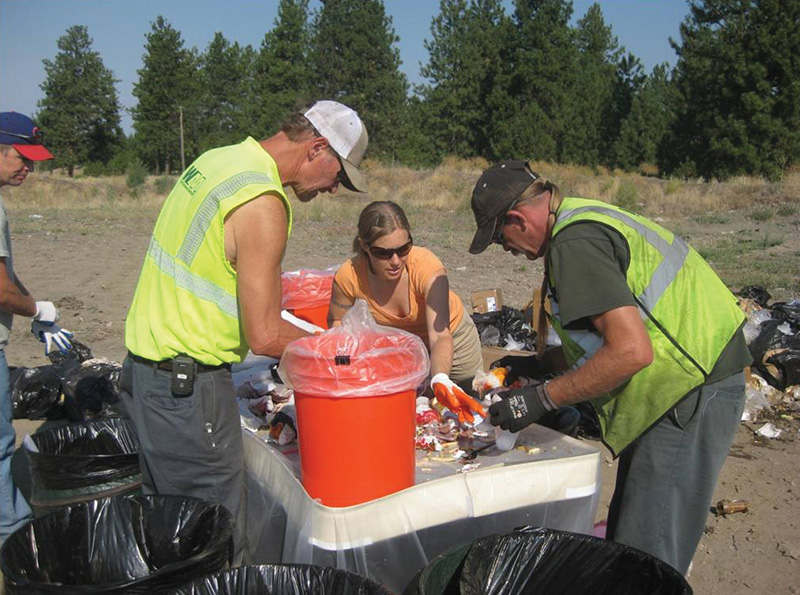CKE Restaurant Holdings Inc. partners with Ecova to develop and implement a strategy for effective resource management.
Interview By Katie Lee
When CKE Restaurants chooses to get serious about energy and sustainability management, the impact is far reaching. With more than 3,500 stores worldwide, CKE operates and franchises Carl’s Jr. and Hardee’s quick-service restaurants as one global brand in 42 states and 31 foreign countries and U.S. territories. Corporate-owned restaurants, all of which took part in the initial environmental audit, number between 800 and 1,000 stores. Guiding CKE along this journey is Spokane, Washington-based Ecova, a total energy and sustainability management company.
Beginning in 2013, Ecova conducted energy and water audits at select restaurants, which identified electric savings of 8% to 14%, plus additional water and natural gas savings, based on a package of projects meeting a 2.5-year payback period. The result was a total of over $1.6 million in potential savings across the portfolio. The operations team has already instituted a new ‘opening and closing checklist’ that could drive an additional $1.2 million in resource savings annually. Restaurant Facility Business recently spoke with Indigo Teiwes, senior manager of strategic planning services for Ecova, to learn more.
RFB: How many CKE restaurants were chosen for Ecova’s energy and water audits, and how were they selected?
 Indigo Teiwes: “The project overall covers the whole CKE portfolio [roughly 1,000 corporate-owned restaurants]. We used insights from a handful of sites that we did facility audits on, and they were selected for a number of different reasons — varying age, varying climate zones, varying prototypes/different designs, and varying levels of energy use and intensity so that we could get a sense of what is the range across the portfolio savings opportunities.”
Indigo Teiwes: “The project overall covers the whole CKE portfolio [roughly 1,000 corporate-owned restaurants]. We used insights from a handful of sites that we did facility audits on, and they were selected for a number of different reasons — varying age, varying climate zones, varying prototypes/different designs, and varying levels of energy use and intensity so that we could get a sense of what is the range across the portfolio savings opportunities.”
RFB: What savings have been identified for CKE? How did CKE’s operations team contribute to the savings?
Teiwes: “For electric savings we identified savings between 8% and 14% at the restaurant facilities that we visited and ultimately those opportunities produced a 2.5-year payback period and potential savings of $1.6 million across the portfolio.
“In addition, we identified what are called ‘behavior-based resource efficiency opportunities,’ which include changes to your operational practices, protocols and behaviors in the restaurants to drive reduced energy and water expenses. The ‘opening and closing checklist’ is part of this. It’s one of the things that is unique and different about the CKE program. It’s not just focused on specific equipment; it is very much working with the operations team, with the facilities team, with the large cross-functional Going Green team, to identify what these behavior changes are and to prioritize actions that fit in with the requirements of the business. Oftentimes, energy management can just be approached from an equipment perspective.”
RFB: I would imagine that such a collaboration would make changes more well received, too?
 Teiwes: “Absolutely. When we talk about the Ecova Blueprint and 5 Keystone approach, we start with data. The second is people. CKE has a cross-functional green team that has representatives from facilities, supply chain, training, operations, human resources, the list goes on — and to your point, the engagement of all of those different stakeholders enables solutions that fit within the way CKE does business and was really able to drive adoption of the programs, which is essential when you’re talking about leveraging behaviors to drive $1.2 million in behavior-based savings.”
Teiwes: “Absolutely. When we talk about the Ecova Blueprint and 5 Keystone approach, we start with data. The second is people. CKE has a cross-functional green team that has representatives from facilities, supply chain, training, operations, human resources, the list goes on — and to your point, the engagement of all of those different stakeholders enables solutions that fit within the way CKE does business and was really able to drive adoption of the programs, which is essential when you’re talking about leveraging behaviors to drive $1.2 million in behavior-based savings.”
RFB: Regarding electric savings, can you mention a couple specific things that were done?
Teiwes: “Lower flow pre-rinse spray valves, which produce both an energy and a water savings (because you’re using less hot water). The average prices for water have increased 30% over the last 4 years. Even though that is a smaller proportion of overall utility expenses, it is a growing proportion, and there’s real opportunity for driving consumption reduction. Another example would be some LED lighting replacements.
“Third is infrastructure and that’s both the physical and operational elements of an organization’s business. So it’s the buildings, equipment and people.
“The fourth keystone is marketing and reporting. The pressures in today’s marketplace are that organizations have energy and sustainability programs in place, and if you are implementing a program and generating benefits, it behooves you to take advantage of that in your external communications.
 “The fifth and final keystone is continual improvement. Energy and sustainability is a rapidly developing field. You know, previously, LEDs were not cost-competitive but now we’re seeing more and more cases where LEDs are a compelling choice for our clients. So staying on top of technology development as well as the different opportunities for proactive resource management or energy and sustainability management, based on the changes to your business, is an important component. Continual improvement is part keeping your finger on the pulse of what the new developments are in the field and where can additional savings be driven.”
“The fifth and final keystone is continual improvement. Energy and sustainability is a rapidly developing field. You know, previously, LEDs were not cost-competitive but now we’re seeing more and more cases where LEDs are a compelling choice for our clients. So staying on top of technology development as well as the different opportunities for proactive resource management or energy and sustainability management, based on the changes to your business, is an important component. Continual improvement is part keeping your finger on the pulse of what the new developments are in the field and where can additional savings be driven.”
RFB: What were some of the specific operational changes that were made?
Teiwes: “I think a good example is the opening and closing checklist. The tendency may have been previously, the first person who gets to the restaurant turns on all the lights, gets things ready, but because there are typically several hours between when the first employee arrives and when the guests would come into the dining room, there’s an opportunity to delay turning on the dining room lights. That’s one specific and small example. But when you add up a number of these behavior change opportunities and look at the savings across the portfolio, sometimes small actions can drive big results. That’s where that $1.2 million figure comes into play.”
RFB: Given the size of CKE, how do you change behaviors in an organization that big?
Teiwes: “One of the projects has been to develop training specifically for different audiences within the organization. We did a training module on the Going Green program, also training for the district managers and VPs of operations on how to use data insight that comes from, for example, internal benchmarking. That really enables the targeting of efforts and financial resources to sites that have the greatest opportunity for improvement. By using that data and focusing efforts to drive savings and changes to those particular sites, we’ve identified an average of $1,400 or 3% annually in utility savings for those individual sites.”
RFB: Is CKE also undergoing new waste and recycling efforts as a result of working with Ecova?
 Teiwes: “Yes. We did what are called ‘waste composition studies’ — translation: Dumpster diving — to identify and really understand what is in their waste stream and what are the opportunities for reducing waste and for diverting waste to recycling streams because, on average across the nation, recycling is cheaper than waste landfills.”
Teiwes: “Yes. We did what are called ‘waste composition studies’ — translation: Dumpster diving — to identify and really understand what is in their waste stream and what are the opportunities for reducing waste and for diverting waste to recycling streams because, on average across the nation, recycling is cheaper than waste landfills.”
RFB: How had CKE been handing corporate sustainability prior to Ecova’s involvement? What spurred them to take this action with Ecova?
Teiwes: “Prior to Ecova’s engagement with CKE, CKE did have and still do have Juliann Rogers, who is now their director of energy, who was really focusing on the equipment approach around energy management. When we started the Going Green program with them, it was driven by investor pressure, asking questions about what is CKE doing on energy and sustainability management? Using resource management (and when I say ‘resource management,’ I’m talking about reducing energy and water and reducing the generation of waste) as a lens actually enables a different view of how you can reduce your utility expenses. Because by reducing consumption or waste generation, you are able to drive bottom-line savings as well as, of course, the environmental benefits through the lower impact of using less.”
RFB: You’ve written for us before about Arby’s in a similar situation. Do you find this to be a general trend in the quick-service industry — are a lot of QSR operators driven by investor pressure to go green?
Teiwes: “I think that different organizations have different drivers that range from investor pressure and competitive parity and really just good business management practice. Implementing a holistic energy management and sustainability program is complex because of the different stakeholders that need to be engaged, and that’s often when clients come to us because they need assistance. What the Ecova Blueprint framework does is provide a rigorous but simple structure for managing the complexity of energy and sustainability management.”
RFB: What advice do you have for other restaurants who might be interested in doing something similar but are worried about cost or other perceived setbacks?
Teiwes: “I have two pieces of advice. One: Get solid data insight. Get a really good handle on your variation of consumption across your portfolio and what these savings opportunities would be if you were to take some of those high energy consuming sites and reduce their energy consumption and therefore their spend.
“The second recommendation would be to engage a cross-functional group in your energy and sustainability program. Oftentimes there are different drivers; one component of the Ecova Blueprint journey is looking at five different drivers that typically impact different parts of an organization. There’s a cost management driver that’s very much an issue for the operations team. There’s also brand reputation drivers for managing energy and sustainability — typically of most concern to the marketing team. Then you have investor pressures, which will be most felt by the investor relations teams. And regulatory drivers, which may be most felt by the facilities management team or the legal team.
“When you look at the different drivers and you engage folks from across the organization, you have a better picture of the overall pressures for energy and sustainability and you have more buy-in into developing a holistic solution that creates benefits for all of the stakeholders involved.”
[NOTE: This article originally appeared as the cover story of the October/November 2014 issue of Restaurant Facility Business magazine. Email the editor at [email protected].]
